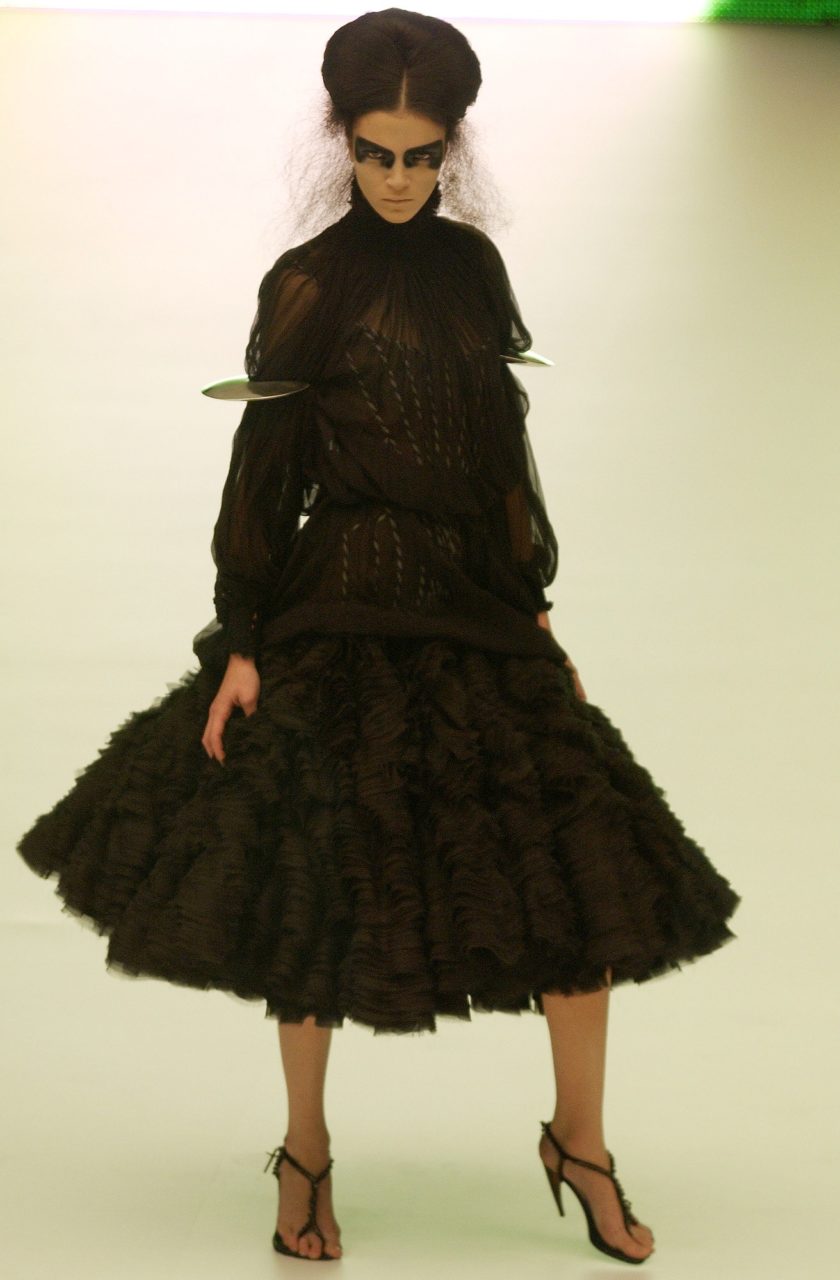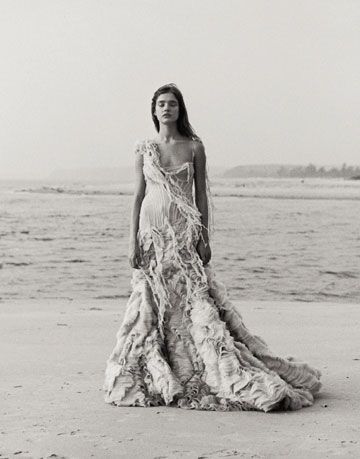Alexander McQueen’s evocative Oyster dress from his Irere collection (2003) is one of his best-known pieces and signifies his avant-garde and provocative approach to fashion.
About the Look
Alexander McQueen (1969-2010) was an artist whose legacy will live on through his many collections that are still admired today. His many noteworthy pieces like the Oyster dress created buzz and opened the doors to opportunities for other designers in the fashion industry. The Oyster dress from his 2003 collection (Fig. 1) was part of the “Irere” collection of spring/summer 2003 and is made of silk in a beige tone.
McQueen layered silk chiffon from the waist down the garment, creating the impression that the dress was formed like a mollusk: “The gown’s complex construction of sand-colored chiffon and organza in graduated layers result in a texture similar to the mille feuille ridging on a shell’s surface” (Johnson 45). As the Victoria & Albert Museum describes:
“Fragile femininity was conveyed in McQueen’s ‘Oyster’ gown, constructed from a bodice of boned tulle and shredded chiffon, its skirt consisting of hundreds of circles of chiffon arranged on the bias to replicate the folds on an oyster shell.” (Bethune)
A corset that ends in a ‘U’ shape was made for the bodice, bringing forth a sense of classic elegance and structure to the otherwise flowy dress. The piece overall resembles a shipwreck and presents an emotion that could be described as serene destruction. The visually striking Oyster dress was included in the Metropolitan Museum of Art’s “Savage Beauty” exhibition in 2011. The museum evocatively describes the classical associations of the dress:
“The hem of the skirt, like the wavy lip of a giant mollusk, further emphasizes the seashell quality of the gown. But unlike Aphrodite, who was born in the foam of the sea and borne to shore on a scallop, McQueen’s beauty is a bruised pearl encased in a deconstructing oyster, the tumbled survivor of the violent action of waves.”
Fig. 1 - Alexander McQueen (British, 1969-2010). Oyster dress, spring/summer 2003. Silk. New York: The Metropolitan Museum of Art, 2003.462. Purchase, Gould Family Foundation Gift, in memory of Jo Copeland, 2003. Source: The Met
Alexander McQueen (1969-2010). Ensemble, Spring/Summer 2003 Ready-to-Wear. Silk. New York: The Metropolitan Museum of Art, 2003.462 Purchase, Gould Family Foundation Gift, in memory of Jo Copeland, 2003. Source: The Met
About the context
Alexander McQueen was a designer from London who emerged during the early 90s, after graduating from Central Saint Martins in 1992. He served as Givenchy’s chief designer from 1996-2001 and most importantly is known for his own namesake label launched in 1992.
The Oyster dress is a McQueen piece from his spring/summer 2003 collection coined Irere. Much like his previous collections and those that followed, Irere represents McQueen’s avant-garde aesthetic. He was known for creating pieces that garnered criticism and applause all at once and for his ability to think outside of the box when designing pieces. Some themes for his other shows include the invasion of Scotland by England (entitled Highland Rape) for his 1995 fall/winter collection or the hybridization of human and amphibian forms titled Plato’s Atlantis (2010 spring/summer). Alexander McQueen spoke openly about the many unique and unusual influences for his work both within his own life and elsewhere. Alexander McQueen: Savage Beauty (2011) quotes McQueen describing his inspirations:
“My collections have always been autobiographical, a lot to do with my own sexuality and coming to terms with the person I am–it was like exorcising my ghosts in the collections.” (Bolton 16)
The Oyster dress seems to have been inspired by a little more than just McQueen’s life. The Victoria & Albert Museum explains that he drew inspiration from the Roland Joffé film The Mission (1986). The movie is set in 18th-century South America and follows a missionary trying to protect a Native tribe from the impeding doom of Portuguese forces. The runway show where the dress was showcased in 2003 was meant to portray a story, as typical of McQueen’s work, and was presented in three segments. The Oyster dress was a part of the first segment (Fig. 2) which also saw models wearing Portuguese, pirate-inspired garments (Fig. 3).
Fig. 2 - Alexander McQueen (British, 1969-2010). Look 18 RTW, Spring 2003. Source: Vogue Runway
Fig. 3 - Alexander McQueen (British, 1969-2010). Look 19 RTW, Spring 2003. Source: Vogue Runway
Fig. 4 - Alexander McQueen (British, 1969-2010). Look 20 RTW, Spring 2003. Source: Vogue Runway
Fig. 5 - Alexander McQueen (British, 1969-2010). Look 21 RTW, Spring 2003. Source: Vogue Runway
Both the Oyster Dress and the tattered chiffon gown that followed it (Fig. 4) refer back to a video McQueen screened prior to the runway show that displayed a model wearing the torn gown seeming to drown in water. The V&A explains:
“The show opened with an underwater film directed by John Maybury that showed a girl in a torn chiffon dress plunge into the sea and appear to drown. But this was not a poignant film of a lost innocent, for Irere, meaning ‘transformation’ in one of the indigenous Amazonian languages, was to tell the story of the girl’s metamorphosis from shipwreck survivor to Amazonian princess, a tale of redemption and survival.” (Bethune)
Their appearance on the catwalk after the video was supposed to convey the idea of survival and rebirth.
The subsequent section of the show represented the models in much darker and violent gowns (Fig. 5) in order to tell a story of survival following trauma, as implied in the opening segment. The final section then ‘explodes’ with color as a representation of rebirth (Fig. 6).
Stephanie Theobald and Alison Edmond interviewed McQueen for the April 2003 article, “Alexander the Great” in Harper’s and Queen (London). The interview followed his Irere collection and asked him where he gathered inspiration from. He responded:
“Of course my work’s edgy— I grew up seeing three sister’s in abusive relationships. One of them was nearly strangled to death. I haven’t watched it all on TV; I’ve been there. Women are warriors, and I’ve got compassion for that.” (129)
This suggests McQueen perhaps used his sisters’ lives as inspiration for the tattered gown and its symbolic meaning. The rest of the show’s segments see strong women adorned in black leather and then emerging finally in bold and brightly colored gowns (Fig. 6).
The Oyster dress is the hard shell that the woman washed ashore in and she herself represents the pearl and good fortune to come. The woman transforms from a ‘victim’ into a warrior, born of a shell. This idea draws contrasts to the mythological story of Aphrodite, whose emergence from a shell, washed up in seafoam, was nothing but graceful. In contrast, in McQueen’s Oyster dress the model appears as a “bruised pearl” (The Met). She who wears the dress is born from an unraveling oyster, the result of crashing in a powerful wave. It’s a dramatic tale that gives the dress a life outside of just being an article of clothing.
McQueen intended for the models to feel and evoke the emotions his pieces were intended to give through their walk and print modeling. Figures 2, 7 and 8 are examples of models wearing the dress both in print spreads and on the runway. Figure 2 illustrates how McQueen sent the models down the runway looking seemingly distressed to mimic the struggle they faced in the crashing waves, and how they overcame it. In Harper’s Bazaar (Fig. 7), model Natalia Vodianova stands in a defiant position in front of a body of water, exemplifying her defiant birth from the oyster. A photograph by Craig McDean for Vogue (Fig. 8) further embodied defiance by showing Vodianova shouting, hands on her hips.
In Alexander McQueen: Genius of a Generation (2010) author Kristin Knox explains McQueen’s ability to captivate the spectator:
“For McQueen, fashion was not necessarily a means for self-expression, but a force to facilitate the opposite, much more akin to the role of the 19th and 20th-century painting and sculpture: to compel the wearer or beholder to surrender to the fantastical and sinister world of which McQueen was the sole artificer.” (7)
In the case of the Oyster dress, the “fantastical and sinister world” was one surrounded by water and resurrection. The Irere collection lived up to McQueen’s reputation, and the Oyster dress became one of the most memorable moments of the collection because of its ability to evoke a sense of fragility and empowerment all at once.
Fig. 6 - Alexander McQueen (British, 1969-2010). Look 49 RTW, Spring 2003. Source: Vogue Runway
Fig. 7 - Peter Lindbergh (German, 1944-2019). Natalia Vodianova for Harper's Bazaar, March 2003. Source: Harper's Bazaar
Fig. 8 - Craig McDean. Natalia Vodianova in Alexander McQueen's Oyster dress in Vogue, January 2003. Source: Flikr
Its Afterlife
T
he Oyster dress was included in the Metropolitan Museum of Art’s exhibition “Savage Beauty” in 2011 (Fig. 8 / Menkes). The garment was placed on display, along with other memorable moments that occurred throughout McQueen’s career as a celebration of his life and artistry following his untimely death. In its display the fabric is literally pulled from the mannequin, giving the already texturized surface even more complexity and volume. Curator Andrew Bolton clearly wanted to refer back to McQueen’s original conception of the collection; the idea of drowning in water as a representation of trauma and yet surviving to experience a monumental rebirth. In its display the dress could be admired for what it represented; strength and endurance in the face of hardship.
Fig. 8 - Alexander McQueen (British, 1969-2010). "Oyster" dress, Irere, Spring/summer 2003. Chiffon and silk. New York: The Metropolitan Museum of Art, 2003.462. Gould Family Foundation Gift, 2003. Source: Alexander McQueen Savage Beauty
References:
- “Alexander McQueen | ‘Oyster Dress’ | British | The Met.” The Metropolitan Museum of Art, i.e. The Met Museum. Accessed March 4, 2019. https://www.metmuseum.org/art/collection/search/88645
- Bethune, Kate. “V&A: Encyclopedia of Collections: Irere.” The Museum of Savage Beauty (blog). Accessed July 7, 2021. http://www.vam.ac.uk/museumofsavagebeauty/rel/encyclopedia-of-collections-irere/.
- Bolton, Andrew, Susanna Frankel, Tim Blanks, Sølve Sundsbø. Alexander McQueen: Savage Beauty. New Haven: Yale University Press, 2011. http://www.worldcat.org/oclc/995473954.
- Johnson et al. Recent Acquisitions: A Selection, 2003-2004. New York: Metropolitan Museum of Art, 2004. http://www.worldcat.org/oclc/57368436
- Knox, Kristin. Alexander McQueen: Genius of a Generation. London: A&C Black, 2010. http://www.worldcat.org/oclc/1060997177.
- Menkes, Suzy. “Alexander McQueen in All His Dark Glory.” The New York Times. May 02, 2011. Accessed March 04, 2019. https://www.nytimes.com/2011/05/03/fashion/03iht-FMET03.html.
- Theobald, Stephanie and Alison Edmond. “Alexander the Great.” Harpers and Queen, 04, 2003, 129-137, https://libproxy.fitsuny.edu:2818/docview/2020119489?accountid=27253.

















